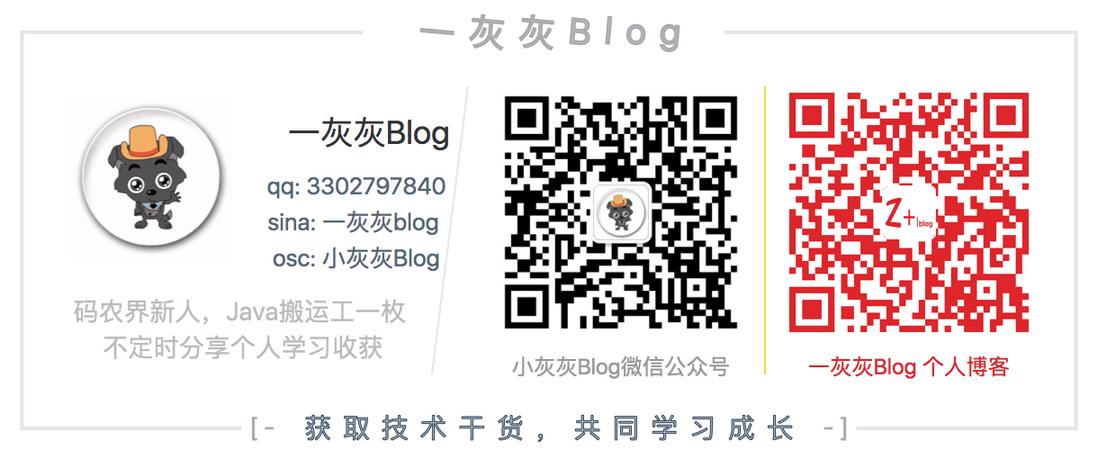【SpringBoot 基础系列】接口上注解 AOP 拦截不到场景兼容
在 Java 的开发过程中,面向接口的编程可能是大家的常态,切面也是各位大佬使用 Spring 时,或多或少会使用的一项基本技能;结果这两个碰到一起,有意思的事情就发生了,接口方法上添加注解,面向注解的切面拦截,居然不生效
这就有点奇怪了啊,最开始遇到这个问题时,表示难以相信;事务注解也挺多是写在接口上的,好像也没有遇到这个问题(难道是也不生效,只是自己没有关注到?)
接下来我们好好瞅瞅,这到底是怎么个情况
<!-- more -->
I. 场景复现
这个场景复现相对而言比较简单了,一个接口,一个实现类;一个注解,一个切面完事
1. 项目环境
采用SpringBoot 2.2.1.RELEASE + IDEA + maven 进行开发
添加 aop 依赖
<dependency>
<groupId>org.springframework.boot</groupId>
<artifactId>spring-boot-starter-aop</artifactId>
</dependency>2. 复现 case
声明一个注解
@Target(ElementType.METHOD)
@Retention(RetentionPolicy.RUNTIME)
public @interface AnoDot {
}拦截切面,下面这段代码来自之前分享的博文 【基础系列】AOP 实现一个日志插件(应用篇)
@Aspect
@Component
public class LogAspect {
private static final String SPLIT_SYMBOL = "|";
@Pointcut("execution(public * com.git.hui.boot.aop.demo.*.*(..)) || @annotation(AnoDot)")
public void pointcut() {
}
@Around(value = "pointcut()")
public Object doAround(ProceedingJoinPoint proceedingJoinPoint) throws Throwable {
Object res = null;
String req = null;
long start = System.currentTimeMillis();
try {
req = buildReqLog(proceedingJoinPoint);
res = proceedingJoinPoint.proceed();
return res;
} catch (Throwable e) {
res = "Un-Expect-Error";
throw e;
} finally {
long end = System.currentTimeMillis();
System.out.println(req + "" + JSON.toJSONString(res) + SPLIT_SYMBOL + (end - start));
}
}
private String buildReqLog(ProceedingJoinPoint joinPoint) {
// 目标对象
Object target = joinPoint.getTarget();
// 执行的方法
Method method = ((MethodSignature) joinPoint.getSignature()).getMethod();
// 请求参数
Object[] args = joinPoint.getArgs();
StringBuilder builder = new StringBuilder(target.getClass().getName());
builder.append(SPLIT_SYMBOL).append(method.getName()).append(SPLIT_SYMBOL);
for (Object arg : args) {
builder.append(JSON.toJSONString(arg)).append(",");
}
return builder.substring(0, builder.length() - 1) + SPLIT_SYMBOL;
}
}然后定义一个接口与实现类,注意下面的两个方法,一个注解在接口上,一个注解在实现类上
public interface BaseApi {
@AnoDot
String print(String obj);
String print2(String obj);
}
@Component
public class BaseApiImpl implements BaseApi {
@Override
public String print(String obj) {
System.out.println("ano in interface:" + obj);
return "return:" + obj;
}
@AnoDot
@Override
public String print2(String obj) {
System.out.println("ano in impl:" + obj);
return "return:" + obj;
}
}测试 case
@SpringBootApplication
public class Application {
public Application(BaseApi baseApi) {
System.out.println(baseApi.print("hello world"));
System.out.println("-----------");
System.out.println(baseApi.print2("hello world"));
}
public static void main(String[] args) {
SpringApplication.run(Application.class);
}
}执行后输出结果如下(有图有真相,别说我骗你 🙃)
3. 事务注解测试
上面这个不生效,那我们通常写在接口上的事务注解,会生效么?
添加 mysql 操作的依赖
<dependencies>
<dependency>
<groupId>mysql</groupId>
<artifactId>mysql-connector-java</artifactId>
</dependency>
<dependency>
<groupId>org.springframework.boot</groupId>
<artifactId>spring-boot-starter-jdbc</artifactId>
</dependency>
</dependencies>数据库配置 application.properties
## DataSource
spring.datasource.url=jdbc:mysql://127.0.0.1:3306/story?useUnicode=true&characterEncoding=UTF-8&useSSL=false&serverTimezone=GMT%2b8
spring.datasource.username=root
spring.datasource.password=接下来就是我们的接口定义与实现
public interface TransApi {
@Transactional(rollbackFor = Exception.class)
boolean update(int id);
}
@Service
public class TransApiImpl implements TransApi {
@Autowired
private JdbcTemplate jdbcTemplate;
@Override
public boolean update(int id) {
String sql = "replace into money (id, name, money) values (" + id + ", '事务测试', 200)";
jdbcTemplate.execute(sql);
Object ans = jdbcTemplate.queryForMap("select * from money where id = 111");
System.out.println(ans);
throw new RuntimeException("事务回滚");
}
}注意上面的 update 方法,事务注解在接口上,接下来我们需要确认调用之后,是否会回滚
@SpringBootApplication
public class Application {
public Application(TransApiImpl transApi, JdbcTemplate jdbcTemplate) {
try {
transApi.update(111);
} catch (Exception e) {
System.out.println(e.getMessage());
}
System.out.println(jdbcTemplate.queryForList("select * from money where id=111"));
}
public static void main(String[] args) {
SpringApplication.run(Application.class);
}
}回滚了,有木有!!!
果然是没有问题的,吓得我一身冷汗,这要是有问题,那就...(不敢想不敢想)
所以问题来了,为啥第一种方式不生效呢???
II. 接口注解切面拦截实现
暂且按下探寻究竟的欲望,先看下如果想让我们可以拦截接口上的注解,可以怎么做呢?
既然拦截不上,多半是因为子类没有继承父类的注解,所以在进行切点匹配时,匹配不到;既然如此,那就让它在匹配时,找下父类看有没有对应的注解
1. 自定义 Pointcut
虽说是自定义,但也没有要求我们直接实现这个接口,我们选择StaticMethodMatcherPointcut来补全逻辑
import org.springframework.core.annotation.AnnotatedElementUtils;
public static class LogPointCut extends StaticMethodMatcherPointcut {
@SneakyThrows
@Override
public boolean matches(Method method, Class<?> aClass) {
// 直接使用spring工具包,来获取method上的注解(会找父类上的注解)
return AnnotatedElementUtils.hasAnnotation(method, AnoDot.class);
}
}接下来我们采用声明式来实现切面逻辑
2. 自定义 Advice
这个 advice 就是我们需要执行的切面逻辑,和上面的日志输出差不多,区别在于参数不同
自定义 advice 实现自接口MethodInterceptor,顶层接口是Advice
public static class LogAdvice implements MethodInterceptor {
private static final String SPLIT_SYMBOL = "|";
@Override
public Object invoke(MethodInvocation methodInvocation) throws Throwable {
Object res = null;
String req = null;
long start = System.currentTimeMillis();
try {
req = buildReqLog(methodInvocation);
res = methodInvocation.proceed();
return res;
} catch (Throwable e) {
res = "Un-Expect-Error";
throw e;
} finally {
long end = System.currentTimeMillis();
System.out.println("ExtendLogAspect:" + req + "" + JSON.toJSONString(res) + SPLIT_SYMBOL + (end - start));
}
}
private String buildReqLog(MethodInvocation joinPoint) {
// 目标对象
Object target = joinPoint.getThis();
// 执行的方法
Method method = joinPoint.getMethod();
// 请求参数
Object[] args = joinPoint.getArguments();
StringBuilder builder = new StringBuilder(target.getClass().getName());
builder.append(SPLIT_SYMBOL).append(method.getName()).append(SPLIT_SYMBOL);
for (Object arg : args) {
builder.append(JSON.toJSONString(arg)).append(",");
}
return builder.substring(0, builder.length() - 1) + SPLIT_SYMBOL;
}
}3. 自定义 Advisor
将上面自定义的切点 pointcut 与通知 advice 整合,实现我们的切面
public static class LogAdvisor extends AbstractBeanFactoryPointcutAdvisor {
@Setter
private Pointcut logPointCut;
@Override
public Pointcut getPointcut() {
return logPointCut;
}
}4. 最后注册切面
说是注册,实际上就是声明为 bean,丢到 spring 容器中而已
@Bean
public LogAdvisor init() {
LogAdvisor logAdvisor = new LogAdvisor();
// 自定义实现姿势
logAdvisor.setLogPointCut(new LogPointCut());
logAdvisor.setAdvice(new LogAdvice());
return logAdvisor;
}然后再次执行上面的测试用例,输出如下
接口上的注解也被拦截了,但是最后一个耗时的输出,有点夸张了啊,采用上面这种方式,这个耗时有点夸张了啊,生产环境这么一搞,岂不是分分钟卷铺盖的节奏
- 可以借助 StopWatch 来查看到底是哪里的开销增加了这么多 (关于 StopWatch 的使用,下篇介绍)
- 单次执行的统计偏差问题,将上面的调用,执行一百遍之后,再看耗时,趋于平衡,如下图
5. 小结
到这里,我们实现了接口上注解的拦截,虽说解决了我们的需求,但是疑惑的地方依然没有答案
- 为啥接口上的注解拦截不到 ?
- 为啥事务注解,放在接口上可以生效,事务注解的实现机制是怎样的?
- 自定义的切点,可以配合我们的注解来玩么?
- 为什么首次执行时,耗时比较多;多次执行之后,则耗时趋于正常?
上面这几个问题,毫无意外,我也没有确切的答案,待我研究一番,后续再来分享
III. 不能错过的源码和相关知识点
0. 项目
- 工程:https://github.com/liuyueyi/spring-boot-demo
- 接口切面拦截: https://github.com/liuyueyi/spring-boot-demo/tree/master/spring-boot/011-aop-logaspect
- 事务: https://github.com/liuyueyi/spring-boot-demo/tree/master/spring-boot/101-jdbctemplate-transaction
AOP 系列博文
- SpringBoot 基础系列 AOP 无法拦截接口上注解场景兼容
- SpringBoot 基础系列实现一个简单的分布式定时任务(应用篇)
- SpringBoot 基础篇 AOP 之拦截优先级详解
- SpringBoot 应用篇之 AOP 实现日志功能
- SpringBoot 基础篇 AOP 之高级使用技能
- SpringBoot 基础篇 AOP 之基本使用姿势小结
1. 一灰灰 Blog
尽信书则不如,以上内容,纯属一家之言,因个人能力有限,难免有疏漏和错误之处,如发现 bug 或者有更好的建议,欢迎批评指正,不吝感激
下面一灰灰的个人博客,记录所有学习和工作中的博文,欢迎大家前去逛逛
- 一灰灰 Blog 个人博客 https://blog.hhui.top
- 一灰灰 Blog-Spring 专题博客 http://spring.hhui.top







**粗体** _斜体_ [链接](http://example.com) `代码` - 列表 > 引用。你还可以使用@来通知其他用户。